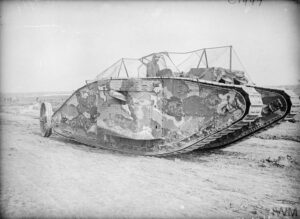Forgotten Friday – The First Tank to be used in Warfare
The idea of a moving vehicle which could provide the military with firepower and protection was not a brand-new concept. However, during WWI the increasing availability of the internal combustion engine, continuous track and armour plate combined the need to produce the ‘Tank’.
The name ‘tank’ came from British attempts to ensure the secrecy of the new weapon under the guise of several water tanks. During WWI the British began the heavy development of the tank and its contents. Ironically the Royal Navy led the way with the First Lord of Admiralty, Winston Churchill and established the Landships Committee in early 1915.
In early 1916, a prototype was adopted by the military, engineers, and industrialists. This meant that the future of the tank was imminent.
Britian first used the ‘tank’ in the Battle of Flers-Courcelette on 15th September 1916.[1]
The Battle of Courcelette, or the Battle of Flers-Courcelette, was part of the Somme offensive during WWI. The Battle of Courcelette was fought from 15th to 22th September 1916. It resulted in thousands of battlefield casualties, but also signalled the start of new thinking in military tactics that would eventually solve the riddle of the trenches and help turn the tide of the war. This was because of the new developments of the ‘Tank’.
On the first day of fighting, more than 57,000 soldiers were brutally murdered or wounded. As a result, the Canadian Corps, the stationed in Belgium were moved south to help with the fighting in the Somme valley. On 15th September, three divisions of the Corps launched an attack on German lines to capture the ruined remains of the small village of Courcelette.
‘The Canadians also went into battle with the latest attempt to break the trench deadlock: the tank. Six “land cruisers,” as they were then called, entered into history’s first major tank battle at Courcelette (an additional tank was kept in reserve). Although slow, plodding, and difficult to move, the large and imposing tanks were an effective psychological weapon against the Germans. Each tank was run by an officer and seven men. Also assigned to each tank were five infantrymen tasked with the removal of casualties ahead of the vehicle.’[2]
Only one of the tanks reached its objective during the battle. The rest were either disabled by shellfire, mechanical failures or stuck in an obstacle. Although, these tanks were able to roll over barbed wire and trenches while firing machine guns and artillery. This capability struck fear and caused some Germans to surrender at the mere sight of them.
The first official photograph taken of a tank going into action, at the Battle of Flers-Courcelette on 15 September 1916. The tank is a Mark I, with a steering tail at the rear of the vehicle that disappeared in many later models. The early tanks were slow and unreliable, shown by the fact that of the 49 tanks deployed for the battle only 25 moved forward at the start of the attack.

THE BATTLE OF THE SOMME, JULY-NOVEMBER 1916 (Q 2488) The first official photograph taken of a Tank going into action, at the Battle of Flers-Courcelette, 15th September 1916. The man shown is wearing a leather tank helmet. Copyright: © IWM. Original Source: http://www.iwm.org.uk/collections/item/object/205078852
© IWM Q 2488
Read more here (C)
[1] https://www.iwm.org.uk/history/how-britain-invented-the-tank-in-the-first-world-war
[2] https://www.thecanadianencyclopedia.ca/en/article/battle-of-courcelette

